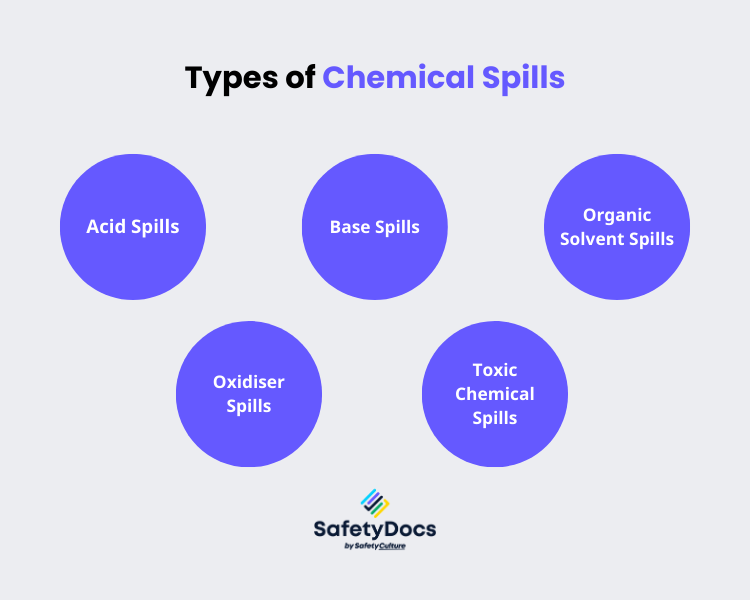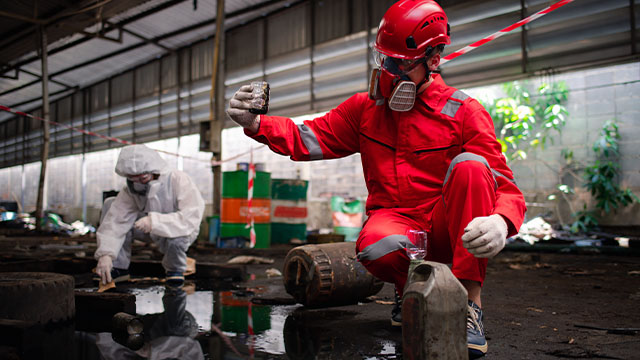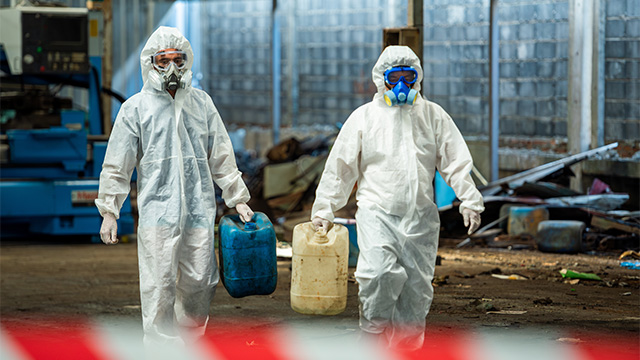Chemical spills are inevitable in any organisation that handles hazardous waste or highly toxic chemicals. No matter how stringent the safety measures are, accidents happen, and preparing for them is crucial. The first line of defence against spills is having a well-crafted response plan.
The purpose of this blog is to provide comprehensive guidance to organisations on developing a chemical spill response plan from the ground up. A complete response plan is a regulatory requirement and a critical component of responsible business practices. Below are the essential steps to create it effectively.
Understanding Chemical Spills
Chemical spills can occur in various settings, including laboratories, industries, and even households. A chemical spill is an uncontrolled release of a hazardous substance, which can pose a significant risk to human health and the environment. Understanding the nature of chemical spills is crucial in preventing and responding to such incidents.
Chemical spills can be categorised into two types: minor and major. Minor chemical spills involve small amounts of less hazardous substances, while major chemical spills involve large quantities of highly toxic or hazardous substances. The severity of a chemical spill depends on various factors, including the type and quantity of the substance, the location of the spill, and the effectiveness of the response.
Minor chemical spills are typically manageable with the resources available on-site, such as spill kits and absorbent materials. These spills usually do not pose a significant threat to human health or the environment if handled promptly and correctly. On the other hand, major chemical spills require immediate professional intervention due to the large volume or highly toxic nature of the substances involved. These spills can have severe consequences, including long-term environmental damage and serious health risks.
Understanding the differences between minor and major chemical spills helps in determining the appropriate response and ensuring that the necessary precautions are taken to protect human health and the environment.
Step-by-Step Guide
Step 1: Identify Potential Hazardous Areas
Start by identifying areas where chemicals are stored or used and could spill. You must identify all the areas within your facility where chemicals are stored, handled, or transported. It's essential to be thorough in this step, as overlooking an area could lead to inadequate preparation for a spill.
Potential Hazardous Areas
Check the following areas thoroughly for potential hazardous chemical spills:
- Storage and handling areas: Identify where chemicals are stored and how they may be moved around.
- Production areas: Include the entire site to cover all potential chemical spill risks.
- Waste storage areas: Determine where hazardous waste is stored, such as drums or tanks.
- Transport routes: Know the paths that transport vehicles take within your facility and assess any potential hazards along those routes.
- Manufacturing or processing equipment: Identify any machinery that uses hazardous chemicals and their potential spill risks.
- Laboratories: Include all lab spaces where chemicals are used or stored.

Step 2: Assess the Risk
Risk assessment involves evaluating the potential risk each identified area poses in the event of a chemical spill. You should consider the type of chemicals used or stored, their volume, their hazardous properties (flammable, toxic, corrosive, etc.), and how they're stored and handled. The proximity of these areas to people and sensitive environments should also be considered.
Chemical spills can be classified in various ways, including the type of chemical spilled, the spill's location, and the spill's size.
By Type of Chemical
- Acid Spills: These involve acids, which are corrosive and can cause burns and other injuries. Examples include sulfuric acid, hydrochloric acid, and nitric acid spills.
- Base Spills: These involve bases (also known as alkalis), which are corrosive and can cause injuries similar to acid spills. Examples include sodium hydroxide and ammonia spills.
- Organic Solvent Spills: These involve organic solvents, which can be flammable or combustible and may also have health effects, such as causing dizziness or unconsciousness. Examples include benzene, toluene, and acetone spills.
- Oxidiser Spills: These involve oxidisers, which can cause or enhance combustion. Examples include hydrogen peroxide and chlorine spills.
- Toxic Chemical Spills: These involve harmful or fatal chemicals if inhaled, ingested, or absorbed through the skin. Examples include mercury, lead, and arsenic spills.
By Location of the Spill
- Indoor Spills: These occur inside a building, such as in a laboratory or storage area.
- Outdoor Spills: These occur outside, such as during transport or at an outdoor storage or use area.
- Waterborne Spills: These occur in a water environment, such as a river, lake, or ocean. An example is an oil spill from a ship.
By Size of the Spill
- Minor Chemical Spill: Training personnel can safely manage small spills using available resources,like absorbent materials and neutralising agents.
- Major Chemical Spill: These are large spills that require professional assistance, such as from a hazmat team or fire department. They may also require evacuation of the area. Examples include an accidental release of a large volume of hazardous material or a large oil spill.
Knowing which is which is crucial in determining the appropriate response.
Step 3: Develop Preventive Measures
Based on your risk assessment, create measures to prevent chemical spills. These measures can include engineering controls, administrative controls, and appropriate personal protective equipment (PPE), as specified in the Safety Data Sheed (SDS) for each chemical.
Engineering Controls
Engineering controls are physical barriers or changes in the workplace designed to eliminate or minimise spill risks. Examples include:
- Secondary containment systems: These are vessels or structures that prevent a spilled chemical from spreading.
- Spill berms: These are raised structures around a containment area that contain spilled chemicals.
- Chemical storage cabinets: These are enclosed and labelled areas specifically designed to store hazardous chemicals safely.
Administrative Controls
Administrative controls, also called work practice controls, are changes in your organisation's policies and procedures to reduce spill risks. Examples include:
- Training: All personnel who may come into contact with hazardous chemicals must receive training on handling and storing them safely.
- Safety procedures: Develop and implement specific safety procedures for handling, using, and storing different types of chemicals.
- Regular inspections: Schedule regular inspections of all identified hazardous areas to ensure compliance with safety measures.
Personal Protective Equipment (PPE)
When administrative and engineering controls are insufficient, personal protective equipment should be used to eliminate or minimise spill risks. This includes gloves, safety glasses, face shields, boots and other items.
Step 4: Establish Emergency Contacts
During a chemical spill, prompt action is crucial. Ensure everyone in your workplace knows who to contact in case of a spill or emergency. Create a list of contacts who should be notified in case of a chemical spill. This list should include:
Internal Contacts
- Emergency Response Team: Identify and train a spill response team that can respond quickly to a spill or emergency.
- Supervisors: These are the first point of contact in case of an incident. They should be aware of the chemical hazards in their areas and how to handle them.
External Contacts
- Emergency Services: Contact your local emergency services, such as the fire department, for assistance in case of a major spill.
- Hazardous Materials (Hazmat) Team: Have the contact information for a professional hazmat team that can assist with larger or more complex spills.
- Medical Facilities: Know where to go for medical assistance in case of injuries from a spill.
- Chemical Suppliers: List your chemical suppliers and their emergency contact information.
Step 5: Create Spill Response Procedures
This involves developing a detailed action plan for responding to a chemical spill. The plan should outline steps for evacuating the area, containing the spill, cleaning it up, and disposing of contaminated materials safely. It must also include procedures for notifying relevant parties and reporting the incident.
The following five steps should be taken:
- Stop the spill: This involves taking immediate action to prevent the spread of the spill and reduce the risk of further exposure.
- Contain the spill: This step involves isolating the spill to prevent it from spreading to other areas and minimising its impact on the environment.
- Isolate the area concerned: This step involves restricting access to the area where the spill occurred to prevent further contamination and ensure the safety of personnel.
- Report the spill: This step involves notifying the appropriate authorities, such as Workplace Health and Safety (WHS) or environmental agencies, about the spill to ensure proper response and compliance with regulations.
- Clean up the spill: This step involves removing the spill and cleaning the affected area to restore it to its original condition.
Step 6: Train Employees
Employee training ensures everyone knows what to do during a spill. Training should inform the risks associated with the chemicals they work with, how to prevent spills, and the procedures to follow if a spill occurs. Regular drills help reinforce this training and ensure employees are prepared.
Training must be conducted by:
- Qualified personnel: Only trained and qualified individuals, like members of the Emergency Response Team or Safety Coordinators, should handle hazardous chemicals or respond to a spill.
- Experienced professionals: Seek assistance from experienced professionals, such as hazmat teams, for major spills or complex situations.
Step 7: Design Reporting Procedures
Clear reporting procedures should be established to report any spills promptly and accurately. This includes designating who the incident should be reported to, what details must be included in the report, and the timeframe within which the report needs to be made.
You can design an incident reporting form that includes the following information:
- Date and time of the incident
- Location of the spill
- Substances involved
- Quantity and extent of the spill
- Hazards posed by the chemicals
- Actions taken to control and clean up the spill

Step 8: Review and Update the Plan
Your Chemical Spill Response Plan should not be static. It's important to review it regularly (e.g., annually) or whenever significant changes occur in your operations, regulations, or when new chemicals are introduced.
Compliance Checklist
Ensure your Chemical Spill Response Plan complies with all relevant regulations and standards in Australia. Some key ones to consider include:
- Work Health and Safety (WHS) Regulations: Under WHS law, any person conducting a business or undertaking at a workplace must make provisions for the containment and management of spills.
- Australian Dangerous Goods Code: Provides guidelines for transporting, storing, and handling dangerous goods.
- Workplace Exposure Standards for Airborne Contaminants: Sets exposure limits for hazardous substances to protect workers' health.
- Model Code of Practice: Managing risks of hazardous chemicals in the workplace: provides practical guidance on how to manage health and safety risks associated with hazardous chemicals.
- Australian Standard AS/NZS 1940: The Storage and Handling of Flammable and Combustible Liquids: Guides storing, handling, and managing spills of flammable and combustible liquids.
- The Globally Harmonised System of Classification and Labelling of Chemicals (GHS): An international system for classifying, labelling, and communicating chemical hazards. This document should serve
Step 9: Documentation
Documenting all aspects of your Chemical Spill Response Plan is essential. This includes keeping records of safety documents, training sessions, incident reports, and any updates or changes made to the plan. These records may be useful for future reference, audits, and continuous improvement.
By understanding the nature of chemical spills and taking these special considerations into account, individuals can help prevent and respond to chemical spills effectively, minimising the risk to human health and the environment.
Special Considerations
When dealing with chemical spills, several special considerations must be taken into account to ensure a safe and effective response. These include:
- Personal Protective Equipment (PPE): Wearing appropriate PPE, such as gloves, lab coats, and respirators, is essential in preventing chemical exposure. PPE acts as a barrier between the hazardous substances and the responder, reducing the risk of injury or contamination.
- Spill Response Team: Having a trained spill response team in place can help ensure a prompt and effective response to chemical spills. This team should be well-versed in the procedures for containing and cleaning up spills, as well as in the use of spill kits and other emergency equipment.
- Waste Disposal: Proper disposal of contaminated materials and waste is critical in preventing further environmental harm. This includes following regulations for hazardous waste disposal and ensuring that all contaminated items are handled and disposed of safely.
- Human Health: Chemical spills can pose a significant risk to human health, and it is essential to take measures to prevent exposure. If exposure occurs, it is crucial to seek medical attention immediately to address any potential health effects.
- Contaminated Clothing: Contaminated clothing should be removed and disposed of properly to prevent further exposure. This helps to minimise the risk of spreading the hazardous substances to other areas or individuals.
- Highly Toxic Substances: Spills involving highly toxic substances require special attention and may require emergency response. These substances can have severe health effects, and it is important to follow specific protocols for handling and cleaning up such spills.
By understanding the nature of chemical spills and taking these special considerations into account, individuals can help prevent and respond to chemical spills effectively, minimising the risk to human health and the environment.
Ensure Workplace Safety with Our Essential Chemical Spill Response Plan
Prioritise safety and compliance in your workplace with SafetyDocs by SafetyCulture.
Our premier offering, the Chemical Spill Response Plan template, is designed to meet stringent safety regulations and provide comprehensive guidance during chemical emergencies. This essential tool is your first step towards a safer, regulation-compliant workspace.
Complement Your Safety Toolkit
While the Chemical Spill Response Plan is fundamental, consider enhancing your safety protocols with our additional templates:
- Chemicals Safe Operating Procedure
- Hazardous Chemicals Safe Work Method Statement
- Chemical Manifest
- Chemical & SDS Register
These resources are tailored to streamline processes and ensure thorough management of hazardous chemicals in any workplace setting.
Remember, an effective Chemical Spill Response Plan can prevent accidents, protect workers' health and the environment, and minimise disruptions to your operations. Be prepared for potential spills and ensure everyone knows what to do in an emergency. Contact SafetyDocs today and let us help you make your workplace safer for everyone.
Our team of experts is dedicated to providing accurate and informative content. Craig Cruickshank, our senior HSEQ advisor at SafetyDocs by SafetyCulture has reviewed this blog post to ensure the highest level of quality.
Learn more about Craig's work on LinkedIn for more industry insights.
Available for instant download and supplied in fully editable MS Word format for use in your business.
Please note that the above information is provided as a comment only and should not be relied on as professional, legal or financial advice.
Share This Article

